Host fabric interface (HFI) to perform global shared memory (GSM) operations
a technology of shared memory and host fabric, applied in the field of distributed data processing systems, can solve the problems of affecting the performance of smp computer systems, affecting the availability of smp data,
- Summary
- Abstract
- Description
- Claims
- Application Information
AI Technical Summary
Benefits of technology
Problems solved by technology
Method used
Image
Examples
Embodiment Construction
[0025]Disclosed are a method and data processing system for generating and processing global shared memory (GSM) operations that complete parallel job execution of multiple tasks on different physical nodes with distributed physical memory that is accessible via a single, shared, global address space (GAS). Each physical node of the data processing system has a host fabric interface (HFI), which includes one or more HFI windows with each window assigned to at most one locally-executing task of the parallel job, although multiple windows may be assigned to a single task. The HFI includes processing logic for completing a plurality of operations that enable parallel job execution via the different tasks, each of which maps only a portion of the effective addresses (EAs) of the shared GAS to the local (real or physical) memory of that node. Each executing task within a node is assigned a window within the local HFI. The window ensures that issued GSM operations (of the local task) are ...
PUM
 Login to View More
Login to View More Abstract
Description
Claims
Application Information
 Login to View More
Login to View More - R&D
- Intellectual Property
- Life Sciences
- Materials
- Tech Scout
- Unparalleled Data Quality
- Higher Quality Content
- 60% Fewer Hallucinations
Browse by: Latest US Patents, China's latest patents, Technical Efficacy Thesaurus, Application Domain, Technology Topic, Popular Technical Reports.
© 2025 PatSnap. All rights reserved.Legal|Privacy policy|Modern Slavery Act Transparency Statement|Sitemap|About US| Contact US: help@patsnap.com



